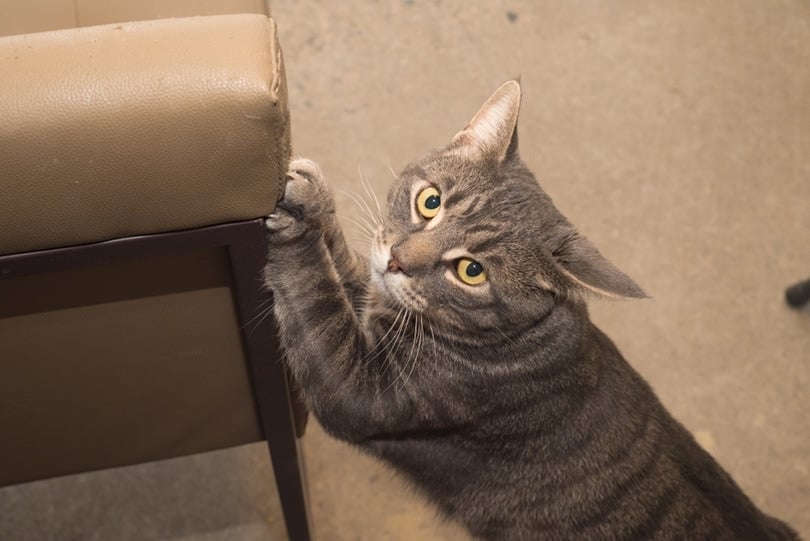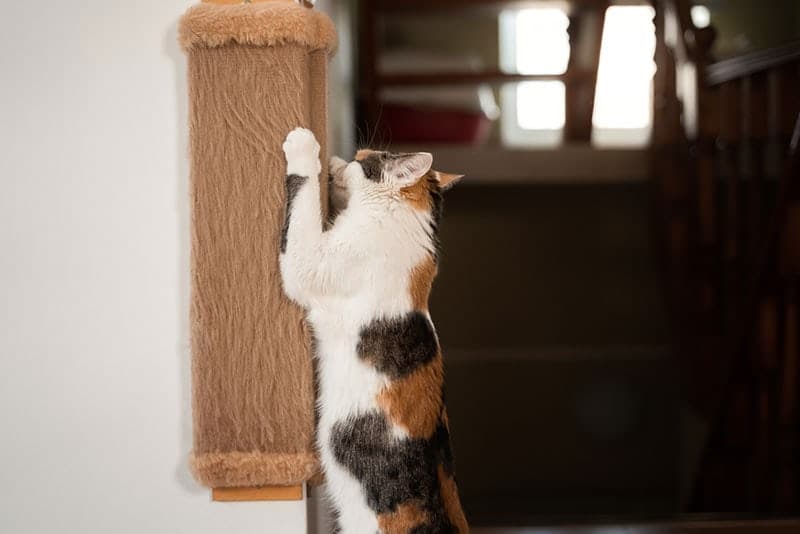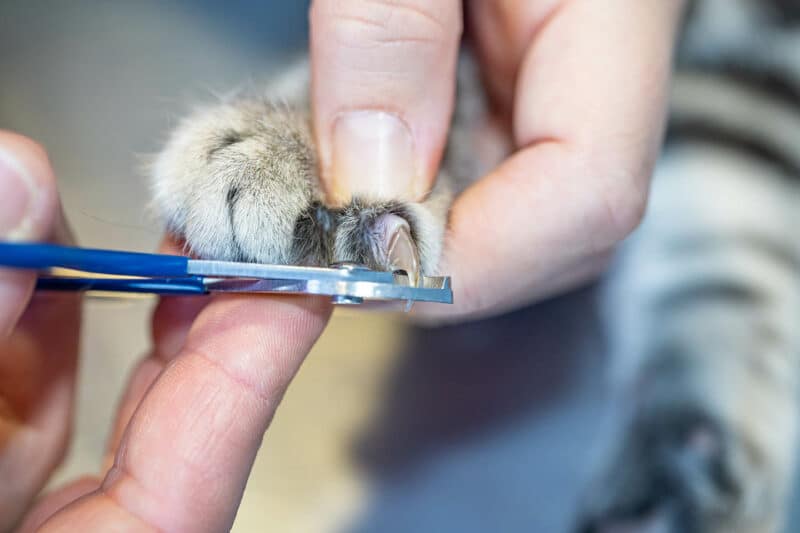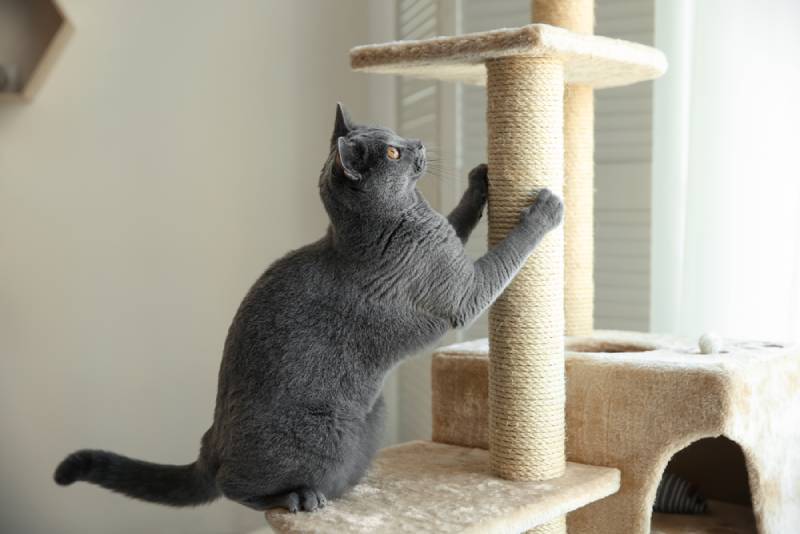Do you adore your cat but detest their destructive scratching habits, especially when it comes to your beloved leather furniture? If so, you’re not alone! In this article, we will explore effective strategies to prevent cats from shredding your furniture. We’ll also delve into why cats love scratching so much, providing you with a better understanding of their behavior.
Understanding Why Cats Scratch Furniture
Contrary to popular belief, scratching furniture is a normal and healthy behavior for cats. It allows them to mark their territory, sharpen their claws, stretch, and release tension. Scratching also serves as a form of emotional release, helping cats reduce anxiety and agitation. So, rather than completely discouraging scratching, it’s important to redirect their attention away from your leather furniture.

Image Credit: Melissa Sue, Shutterstock
The Top 6 Tips to Protect Your Leather Furniture
Preventing your cat from scratching your furniture requires time, consistency, and patience. Here are six expert tips to help you save your leather furniture while allowing your cat to engage in healthy scratching behaviors.
1. Find a Scratcher for Your Cat
The first step is to provide your cat with an enticing alternative to your furniture. Invest in a high-quality scratcher and, if you have multiple cats, make sure there are enough scratchers for all of them. Demonstrate the scratcher’s appeal by running your nails over it, showcasing the interesting sounds and textures.
Sprinkle catnip on the scratcher to further entice your feline friend. If you’re looking for a reliable option, we highly recommend the Hepper Hi-Lo Scratcher. Its versatile design and replaceable cardboard insert make it a top choice for both you and your cat.
2. Strategically Place the Scratcher
To effectively redirect your cat’s attention, strategically place the scratcher near their favorite furniture and within the family’s communal space. By doing so, you’ll encourage your cat to choose the scratcher over your leather furniture. Remember, cats are social creatures and are more likely to use a scratcher that is close to where the family spends time.

Image Credit: Evgenia Terekhova, Shutterstock
3. Make Your Furniture Less Appealing
In addition to providing a scratcher, you can make your leather furniture less tempting for your cat. Place double-sided tape on the furniture, which cats find unpleasant when they try to scratch. Alternatively, you can spray your furniture with a citrus spray, as cats generally dislike the smell. Remember, avoid spraying your cat directly as it may frighten or harm them. The goal is to make the furniture’s scratching experience unpleasant, not terrifying or painful.
4. Keep Your Cat’s Nails Trimmed
Although trimming your cat’s nails won’t stop their scratching behaviors, it can minimize the damage to your leather furniture. Consider placing claw caps on their nails or regularly trimming them to prevent claw marks on the furniture.

Image Credit: GaiBru-Photo, Shutterstock
5. Provide Enrichment Opportunities
If your cat is scratching excessively, it may be a sign that they need more mental and physical stimulation. Enrich their environment with cat trees, perches, interactive toys, puzzle feeders, or even a bird feeder near the window. Spending quality playtime with your cat is also crucial, as it stimulates them mentally and emotionally.
6. Seek Behavioral Specialist Assistance
If all else fails, don’t hesitate to seek professional assistance from a behavioral specialist. Excessive scratching behaviors may indicate an underlying issue, and a specialist can help identify and address it. They may provide valuable behavioral modification techniques and effective training advice.

Image Credit: megaflopp, Shutterstock
Bad Tactics to Avoid
While the tips above provide numerous effective methods, it’s important to steer clear of certain tactics. Avoid the following methods and understand why they should be omitted when addressing your cat’s scratching behavior.
1. Declawing Your Cat
Declawing, an invasive procedure that removes the claw and the first toe bone, is a painful and drastic measure. It can lead to frustration, anxiety, and aggression in cats. Remember, scratching is a necessary behavior, and depriving cats of this natural behavior can have severe consequences on their physical and mental well-being.
2. Yelling or Punishing Your Cat
Yelling or punishing your cat for scratching furniture is counterproductive. It confuses and frightens them, potentially leading to anxiety and fear-based aggression. Harsh correction methods damage the bond of trust between you and your pet. Instead, focus on positive reinforcement techniques to encourage appropriate behavior and reward desired actions.
3. Physically Forcing Your Cat to Use a Scratcher
Physically forcing your cat to use a scratcher is ineffective and harmful. Cats do not respond well to being forcibly handled, and it can create negative associations with the scratcher. This approach will only make your cat avoid the scratcher altogether, undermining your efforts to encourage its use.

Image Credit: New Africa, Shutterstock
Frequently Asked Questions
Q: Is it possible to completely stop a cat from scratching furniture?
A: It’s important to redirect your cat’s scratching behavior rather than trying to eliminate it entirely. Scratching is a natural behavior that provides numerous benefits for cats. By providing alternative scratching surfaces, such as scratchers, you can protect your furniture while allowing your cat to engage in healthy scratching habits.
Q: How long does it take to train a cat to use a scratcher instead of furniture?
A: Training your cat to use a scratcher may take some time and patience. Each cat is unique, and the duration of the training process can vary. Consistency and positive reinforcement are key factors in successfully redirecting your cat’s attention to the scratcher.
Q: My cat only scratches certain pieces of furniture. How do I prevent this behavior?
A: Cats may have preferences when it comes to the material or location of furniture they choose to scratch. Consider placing scratchers near the furniture that your cat tends to target. By providing an appealing alternative nearby, you can redirect their attention and protect your desired piece of furniture.
Conclusion
Teaching your cat to stop scratching your leather furniture may require time and effort, but it is achievable. Focus on methods that make the scratcher appealing rather than tactics that frighten or harm your cat. Positive reinforcement, patience, and consistency will go a long way in redirecting your cat’s scratching behavior. By following these expert tips, you can save your leather furniture and strengthen the bond between you and your feline companion.
Featured Image Credit: RJ22, Shutterstock